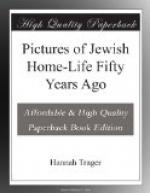“‘Don’t unsettle their minds, dear,’ she whispered softly to me. ’I don’t want to,’ I said; ’I only want to show them that, though such things are done in other countries, there is no sin in it as they have been brought up to believe.’ ‘Well, well!’ she said, ’let us hope God will restore our beloved land to us in his own good time, and then we shall again, as in days of old, celebrate such Festivals!’
“We all said ‘AMEN,’ most heartily, to this wish.
“In my next letter I will tell you of our friend’s engagement and marriage. Your loving cousin, Millie.”
ENGAGEMENT AND WEDDING CEREMONIES
The hearers waited with eagerness for the next Friday evening, as they enjoyed so much hearing those interesting letters.
The next Mr Jacobs read was this:
“Hulda is only fifteen years of age, and has already been married six months. If she were dressed as girls are dressed in England, she would really look beautiful; but her beauty is, I think, marred by the silk handkerchief she wears on her head, which covers half her forehead and her ears, so that none of her hair can be seen, I mean that part of it that was shaved off. Over the silk handkerchief she wears a black velvet band, to which gold coins are attached and these are put on so coquettishly that it makes the head-gear look quite artistic. Sometimes she wears ornaments with pearls in them. These special trinkets are, of course, worn only on Sabbaths and Festivals or some other special occasions.
“The shaving of part of the young wife’s head the day after her marriage is a custom to prevent young married women from being tempted by vanity to show off their hair, which is generally in Palestine very beautiful. The poor things cover up the part so well that there is no fear of any of it being seen.
“Hulda is tall and well-developed for her age, and lively as a cricket, always ready to play and laugh and joke with us. She started by telling me: ’I was invited to visit my betrothed’s family during the holidays, and my future mother-in-law let me help her with the baking and cooking, and was specially pleased with the way I stretched out the dough for the lockshen—I made it look so thin, like a paper wrapper. She told me that I would make a good housewife. Then I showed all the family some of the linen garments I had made and had with me, and the crochet I had trimmed them with.’
“Here Hulda turned to me and said: ’our mothers encourage us at eight years of age to begin to make garments for our trousseaux, and at the age of ten we start to crochet lace and embroider, so by the time we get married we have all our things ready, for they cannot be bought ready-made in Palestine. When we become betrothed we work our future initials on our things and make our dresses.’




